We all know that buying a ceiling fan is a very important task. We know it can be confusing and frustrating, especially when you don’t know where to start looking for the right product.
In order to make sure that you get the best deal possible on your new fan, we have prepared this comprehensive ceiling fan buying guide for you. It will cover everything from choosing an appropriate ceiling fan for your home, to understanding how different designs affect the performance of your fan.
You will learn about all of the different types of fans available today, as well as what features they offer that might be beneficial for your needs.
We’ve even included some tips on how to keep your fan running smoothly over time so that it continues to provide comfort and functionality throughout its life cycle.
Here’s How We Curated This Buyer’s Guide!
We took an honest look at all the information available online, and we also managed calculated work to give you a quick overview of the specifications. Our research involved combining information from multiple sources and then presenting it in a way that was easy to understand.
We’re confident that this guide will be a useful resource as you make your decision, and most of your confusion gets resolved after reading this guide. We hope this guide has everything that can help you find an awesome ceiling fan for your home!
How Do Ceiling Fans Work?
Ceiling fans are a great way to cool your home in the summer, but what makes them work?
The unit draws air in from the top and directs it down along the blades towards the hub, where it releases into the surrounding area. The air then moves back up through tiny holes at each blade’s tip before returning to its original position inside the unit.
The components of the ceiling fan include the motor, light kit, and blades. The motor is what moves the blades around and turns them on and off. The light kit contains all of the fixtures that make up a fan’s lights. This can include bulbs or LED lights.
Finally, there are usually two or three blades that rotate at different speeds to create airflow through your room. If we specifically understand the role of blades, so they help the fan move in the same way as window fans do.
Did You Know?
There are also forward and reverse mechanisms of ceiling fans that make them work as both a source of cool air and heat!
Want to know the cooling and heating mechanisms of these fans? Let’s figure it out!
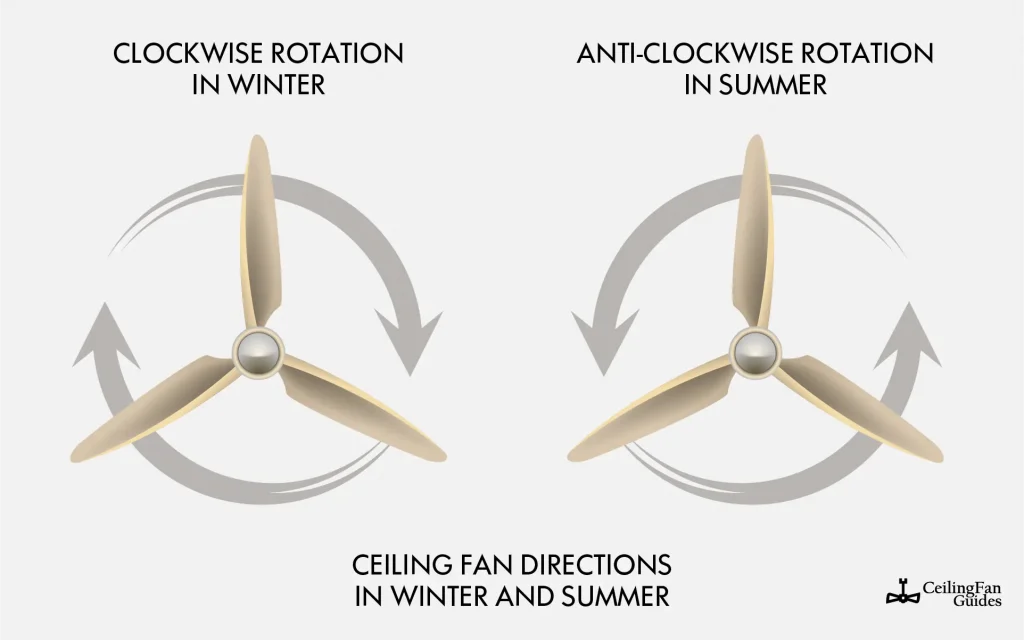
Forward Working Mechanism (The Summers Deal):
The forward working mechanism pulls air from the room and directs it down through the blades connected to a motor. The motor pushes air up through the blades and out of your room. This pulls the air upward through your room and provides a cooling effect.
Reverse Working Mechanisms (The Winters Deal):
The reverse working mechanism does the same thing as the forward working mechanism, but it moves in reverse (clockwise). This causes cool air to rise up from below and warm air to descend from above so that you stay warm.
Read More: How to Use a Ceiling Fan in Winters for Heat Circulation
How To Choose The Right Ceiling Fan?
There are various types of fans available on the market, each with its own set of features and applications. The most common type of fan is a three-blade, but there are also four and up to six-blade fans available.
Choosing a fan is not as easy as it seems. You must be aware of different things you should look for in a product. Also, keeping a prior knowledge of purchasing a ceiling fan can save you from different problems you can face in the market when you have to buy a reliable fan!
You need to know about the features and benefits each type of fan offers so that you can choose the best one for your home or office space.
However, choosing a fan does not have to be difficult. Here are some tips on how to choose the right fan for your home:
Essential Things to Look For Before Buying A Ceiling Fan
Before you start shopping for a ceiling fan, you should know what makes good quality. There are several ways to tell if a ceiling fan is of good quality.
Here, we have listed and described some of the most important things you need to check out before purchasing a fan.
One way is by looking at its construction. A well-made ceiling fan will have a sturdy body and won’t wobble when it turns on. You may also want to look at the materials used in the fan blades and the motor housing, as these are also important factors in determining quality.
Types of ceiling fans based on different locations and areas
Ceiling fans are available in many different shapes and sizes to suit any type of room, from bedrooms to kitchens and everything in between.
Choosing the right fan type for your home can be confusing. So we’ve put together some types & styles of fans you can find to get all the information you need before making a final decision!
Read: 5 Common Types of Ceiling Fan Styles
Patio Fans (For Outdoors)
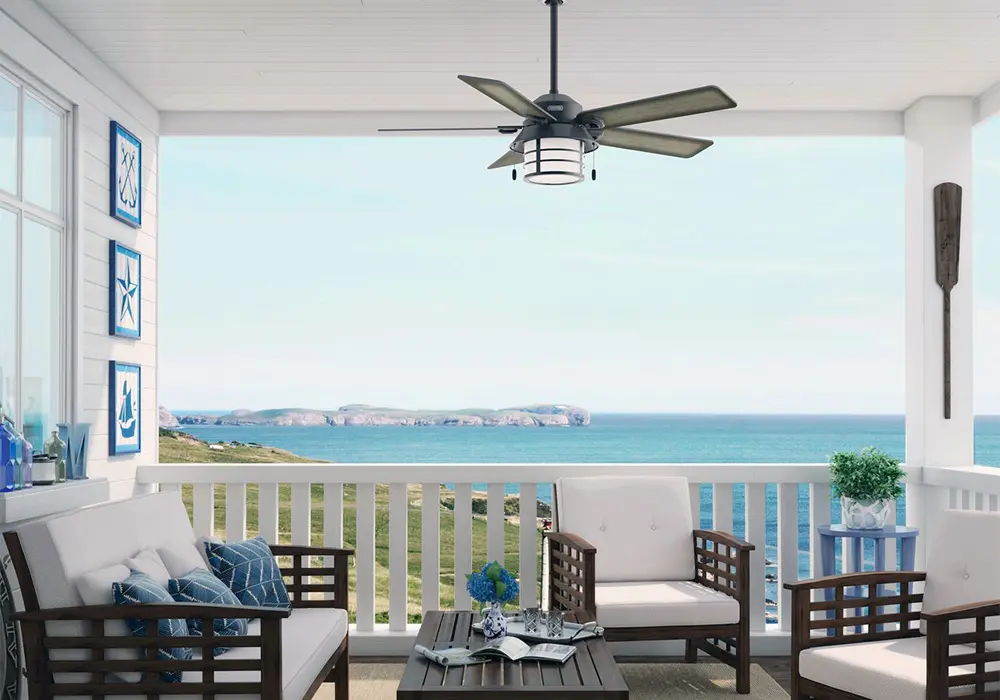
Patio ceiling fans are ideal for patios, porches, and other outdoor spaces. You can use them in wet or dry locations, so you won’t have to worry about your fan malfunctioning when you need it most.
In fact, this type of fan is one of the best options if you live in an area with humid summers or rainy winters (like central Florida).
As such, patio fans are perfect for use on patios during the summer months, when humidity levels rise high enough to cause condensation inside your home.
There’s also no reason why these types of fans should only be used outdoors, they work just as well indoors.
Directional Ceiling Fans

A directional fan moves air in a specific direction by design. A good example of this would be the oscillating table fans, which allow you to point their blades at the ceiling and direct their flow of air towards your body.
This type of fan is great for rooms with lots of open space—especially those big enough for an entire family or company meeting!
Tip!
If you need something more compact and less powerful than an oscillating table fan, then consider buying directional ceiling fans to circulate air in large rooms instead.
Low Profile/Flush Mount/Hugger Ceiling Fans (For Indoors)
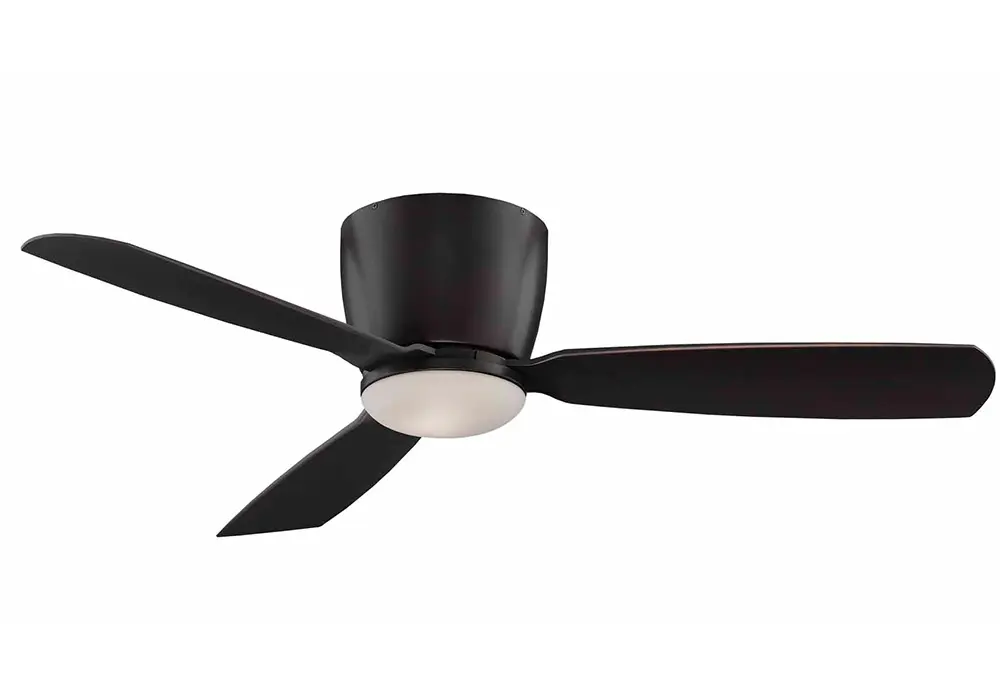
Low profile fans fit under low ceilings and suit many rooms. People also call them flush mount or hugger fans because their small base sits flush with the ceiling, making them look like part of the wall.
They can be used in a variety of rooms, from kitchens to bedrooms. They come in a variety of styles and finishes, including:
Read: Best Kitchen Ceiling Fans
Dual Motor Ceiling Fans
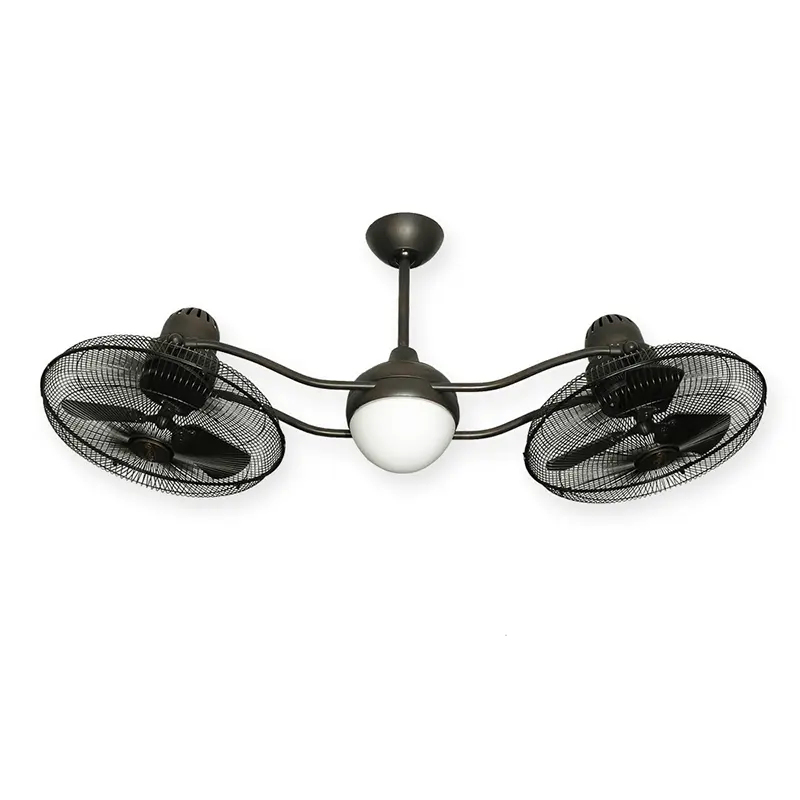
Dual motor fans are the most powerful fans you can buy. They’re also the best to use in large rooms, and they have a high CFM rating (cubic feet per minute). The higher the CFM rating, the faster your air will move through the room.
A good dual motor fan should have no problem cooling down whatever room it’s in—even if that room has walls or furniture blocking its path of airflow.
High Volume Low Speed (HVLS) Fans
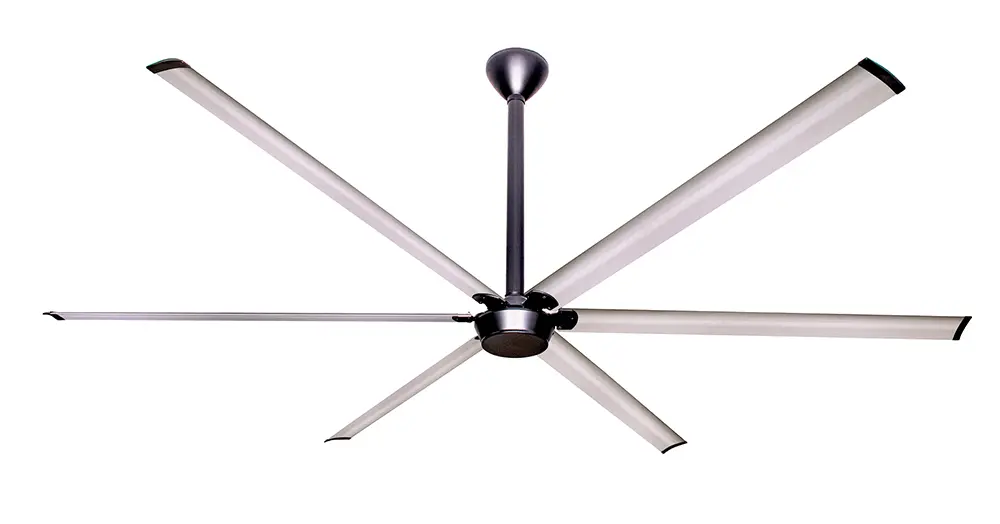
High-volume low-speed (HVLS) ventilation is an effective way to provide fresh air and oxygen in large spaces.
These systems are designed to ventilate vast spaces, including industrial areas and livestock. They work by pulling air through a large area of ductwork to distribute it throughout the space.
The design of this fan optimizes ventilation for vast spaces, allowing you to enjoy the benefits of a high-speed ventilation system without sacrificing space.
Understanding Damp Rated, Wet Rated & Dry Rated Ceiling Fans
Ceiling fans come in three different categories based on the weather conditions or surroundings: dry, damp, and wet.
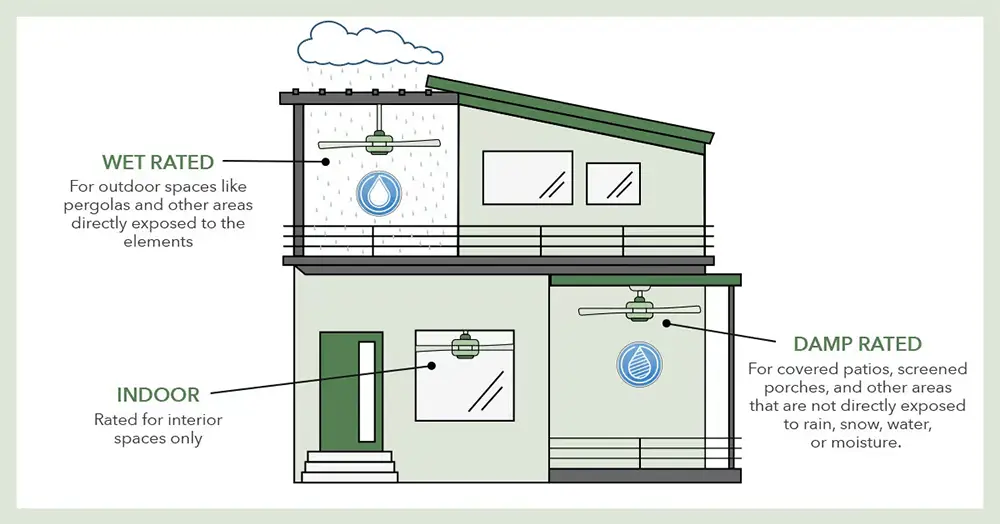
Dry Rated Fans (For Dry Indoor Areas)
Dry-rated ceiling fans are designed for use in indoor areas that are not exposed to moisture or humidity.
The blades used in dry rated fans are typically metal, wood and plastic which are not resistant to moisture and humidity. They can be used in bedrooms, living rooms, lounges, and other indoor areas that are not directly exposed to water and moisture.
They usually have standard components and motors that aren’t sealed and coated, making them unsuitable for outdoor use or in rooms with high moisture and humidity levels. The motors inside are designed for quieter operation, ensuring inner spaces remain quiet and free of noise.
In most cases, these fans are better suited for environments where the humidity level is below 50%, but it can vary depending on your local climate. You will want to keep an eye on the temperature of your room so that you don’t start running the fan too often.
Dry-rated fans are usually priced lower than damp-rated and wet-rated fans as they do not have special features and materials to save them from moisture.
Wet Rated Fans (For Moisture Exposed Outdoor Areas)
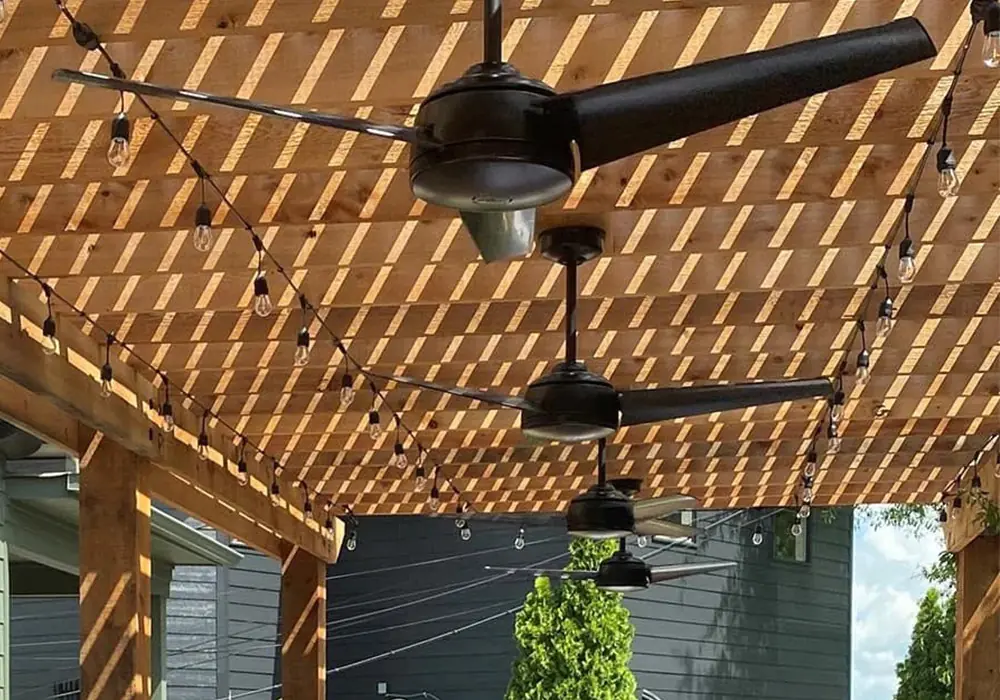
Wet rated ceiling fans are made of a durable material that is resistant to moisture. They are meant for outdoor use, and they can withstand rain and snow storms or direct exposure to a moist environment outside.
They have a sealed motor to protect against water exposure and sealed blades to prevent water from getting inside the fan. The materials are also resistant to corrosion, such as aluminum or coated steel, which are water resistant.
This means that if water seeps into the fan’s housing, fan motor and its electrical components, it will not cause damage to the fan or its motor and the fan will keep running smoothly for years and years. Hence its strong body makes it a versatile option to install in outdoor locations where humidity is present.
These fans have the ability to withstand all humidified weather conditions such as rain and snow, and can be installed in areas including:
Read: Best Ceiling Fans For Garage
Wet-rated fans are suitable for coastal areas and beachfront houses and apartments. Their blades are usually coated with UV protection, which also prevents their color from fading if they are directly exposed to sunlight.
These fans can be installed in areas where there are no windows or doors, and they will provide you with a breeze while keeping moisture out.
A wet location fan is also great for outdoor kitchens and living spaces that do not get much natural light.
Read: 8 Things to Know Before Buying an Outdoor Ceiling Fan
If you are buying a wet-rated fan, you need to know that it should be installed in the covered outdoor areas mentioned above. And they should not be fully exposed to open areas.
Damp Rated Fans (For Moisture Exposed Indoor & Outdoor Areas)
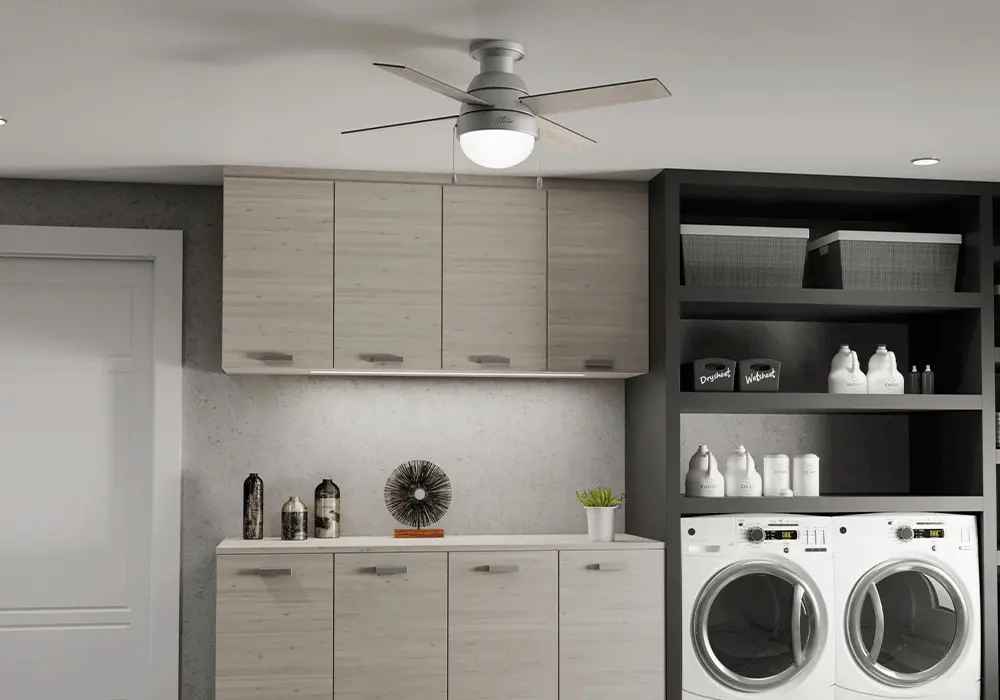
Damp-rated ceiling fans are designed for indoor use where the humidity levels are usually higher, such as in basements, bathrooms, laundry rooms, and kitchens. They can withstand moderate levels of humidity and moisture.
The term “damp rated” refers to the basic construction of these fans, which means that they also have sealed motors, just like wet-rated fans, that make them moisture and water-resistant.
This means that if you have a wet area in your house, then you can use a damp-rated ceiling fan without worrying about mold growing inside of it because it won’t get wet out of the rain or snow.
They should not be used in completely exposed areas that have direct contact with water. Damp-rated fans are designed with rust and corrosion-free materials, such as aluminum and steel, just like wet-rated fans.
Damp-rated fans are usually less expensive than wet-rated fans and offer a good balance of durability between dry-rated and wet-rated fans.
If you’re looking to install a fan in a damp location, there are some things that you should keep in mind.
The Indoor Damp Location Fan is designed for a location with high humidity and moisture levels, like a kitchen or a laundry room. The fans are typically installed to help reduce the condensation on the ceiling from showers and baths.
Takeaway!
Damp fans can handle moisture, but not as much as wet rated ones. Wet fans are designed to withstand more moisture than damp fans and are usually more expensive.
Read: Putting Ceiling Fans in the Kitchen – Yes or No? [4 Ideas]
Damp Rated vs Wet Rated vs Dry Rated Fans: The Key Differences
In simple words, damp-rated fans are a slightly toned-down version of wet-rated fans. have features similar to those of a wet-rated fan, but they are designed to be used in indoor spaces where the humidity level is high. See this chart below for a clear understanding.
| Feature | Damp Rated | Wet Rated | Dry Rated |
|---|---|---|---|
| Suitable for use in damp areas | Yes | No | No |
| Suitable for use in humid areas | Yes | Yes | No |
| Suitable for use in wet areas | No | Yes | No |
| Suitable for use in outdoor areas | No | Yes | No |
| Suitable for use in indoor areas | Yes | Yes | Yes |
| Suitable for covered outdoor & indoor areas with high humidity | Yes | Yes | No |
| Moisture protection | Moderate | Heavy | N/A |
| Corrosion free | Yes | Yes | Yes |
| Can withstand direct environment exposure | Rarely | Yes | No |
Ceiling Fan Sizes Based On Room Area
| Room Type | Room Measurements | Fan Size (inches) | Watt Used | Daily Running Hours | Cost Per Day (USD $) |
|---|---|---|---|---|---|
| Small Bedrooms | 2.8m x 2.5m | 29″-36″ | 55 W | 3 hrs/day | $0.0272 |
| Standar Bedrooms | 3.2m x 4m | 36″-48″ | 75 W | 3 hrs/day | $0.0506 |
| Small Living Rooms | 3m x 3.2m | 36″-42″ | 65 W | 3 hrs/day | $0.0380 |
| Standard Living Rooms | 5.6m x 6.1m | 44″-50″ | 80 W | 3 hrs/day | $0.0576 |
| Large Living Rooms | 4.6m x 8.5m | 52″ | 84 W | 3 hrs/day | $0.0635 |
Ideal Size For Small Bedrooms: 29-36 inches
Small bedrooms are smaller than standard bedrooms, and therefore a large fan is not necessary. If you have a small bedroom that measures 2.8m x 2.5m in length and area, it may be best to choose a smaller fan that matches the size of your room; preferably between 29-36 inches.
A good rule of thumb is to measure the width and depth of your room before making any purchases on fans or light fixtures.
Ideal Size For Standard Bedrooms: 36-48 inches
Having a standard bedroom having area of 3.2m x 4m needs a little more ventilation than small bedrooms. We recommend that the fan size, in this case, should be 48 inches, so you can easily replace your old one with a new one.
If your room has an unusually high ceiling and you want to keep it low without having to hang anything on the walls, standard-size fans are ideal for that reason as well!
Ideal Size For Small Living Rooms: 36-42 inches
Small living rooms are usually not very large, not very high, and not very open. They are also often in poor condition with a low ceiling height and poor lighting. In short: small living rooms can be hard to find!
If you have a small living room of 3m x 3.2m, then consider a fan that is 36-42 inches. This will ensure that you get the most from your fan and also prevent any issues with airflow being restricted by the height of the ceiling.
Ideal Size For Standard Living Rooms: 44-50 inches
There could be different standard sizes for living room. But if you have this measurement (5.6m x 6.1m) of the living room then consider purchasing a 44-50 inches ceiling fan.
For smaller rooms (less than 45 inches wide), try using a fan with speeds between 3500-4500 RPM as opposed to lower speeds like 1800 RPM, which can cause noise problems in quiet areas of your home.
Ideal Size For Large Living Rooms: 52 inches and up
Large living rooms require a larger fan. For a 4.6m x 8.5m large living room, a 52-inch ceiling fan is required.
It’s probably time to consider replacing your current circular ceiling fans with something more powerful. You can purchase five-inch blades or even larger ones if you want to go all out and get something truly impressive.
Which Ceiling Fan Parts are Important to Check?
Motor
If you’re buying a new ceiling fan for yourself or someone else in your home, it’s important to know what kind of motor it uses so that you can make sure they get exactly what they need when they install it!
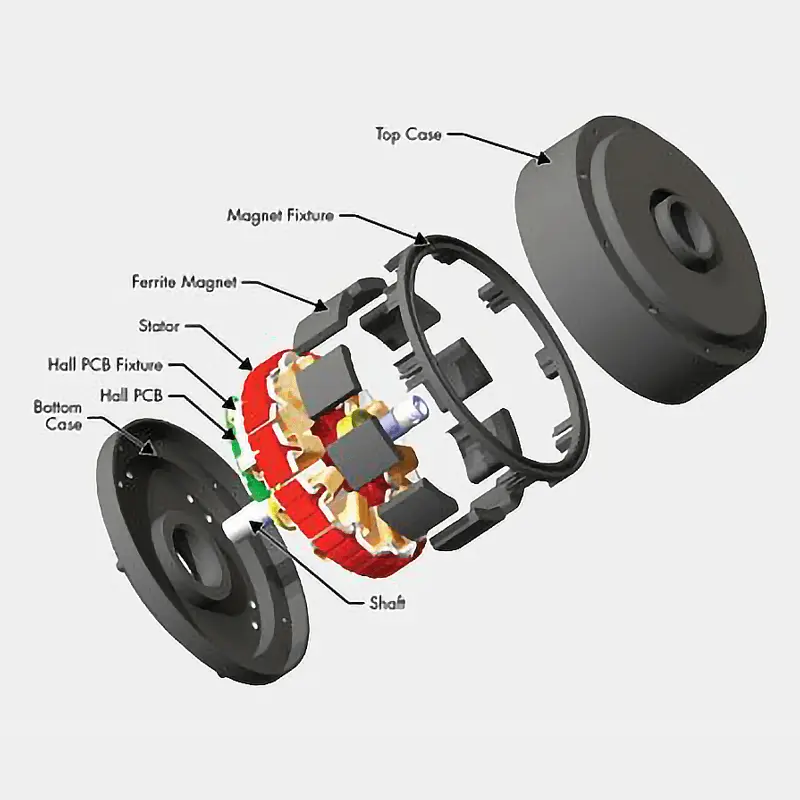
There are three main types of motors: induction motors (also known as brushless motors), squirrel cage motors (also known as capacitor operated), and micro-computers controlled by microprocessors (microcontrollers).
Each type has its own advantages, but there are some common features between them that can help determine which one would be best for your situation.
Blades
The blades are the most visible part of a ceiling fan. They usually come in wood, plastic or metal frame and can range in shape from flat to curved.
Most have a wing-like shape that extends from one side of the blade to another, though some may have an angled edge instead.
A rubber belt connects each blade to its motor (the device that turns it).
Tip!
Metal or plastic blades are usually used indoors because they’re less likely to warp or break than wood. The size and shape of your ceiling fan’s blades will depend on the room you’re in.
If you have a large space like an open kitchen or living room, then it’s best to choose longer blades with more surface area. Smaller rooms will benefit from smaller fans and less wind resistance.
Light kit (if applicable)
The light kit is a part that holds the light bulbs. It’s usually included in the package, but not always. If it’s not included, you can still find it at your local hardware store or online.
The light kit is made of plastic and attaches to the motor or blades of your fan with screws or bolts that come with it when you buy a new fan. This will allow you to easily replace burned-out bulbs without hassle!
Down Rod and Mounting System
Downrods and mounting systems are the important parts you should ensure in the product before buying a ceiling fan. It connects your fan to a higher ceiling.
These downrods come in different lengths, ranging from 6′ to 10′. They can be made of metal or plastic and fixed or adjustable.
The below ceiling fan downrod length chart can help you determine the height of the ceiling so you can get the best downrod length of your fan.
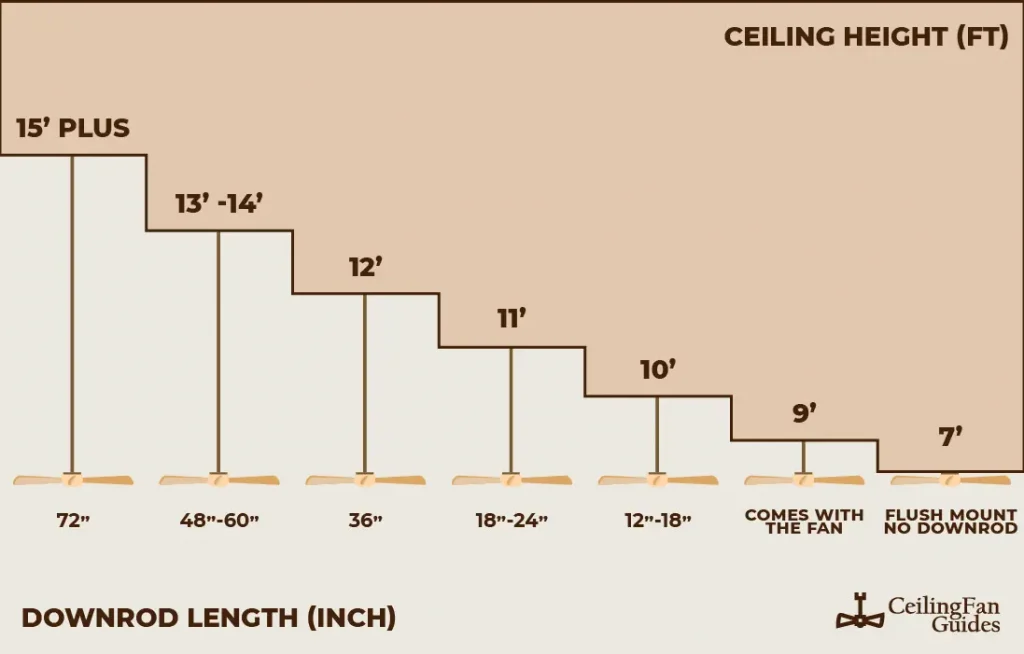
The type of downrod you choose depends on the height of your ceiling and what kind of fixture you want to hang from it.
If you’re installing a light fixture above an existing one, then there’s no need for anything besides an adapter plate (which is available separately).
Check out: How To Choose The Right Ceiling Fan Downrod Length?
Fan Blade Types
Ceiling fans come in various blade types, but what’s the difference between them?
There are some types of blades made of different materials:
Metal Blades
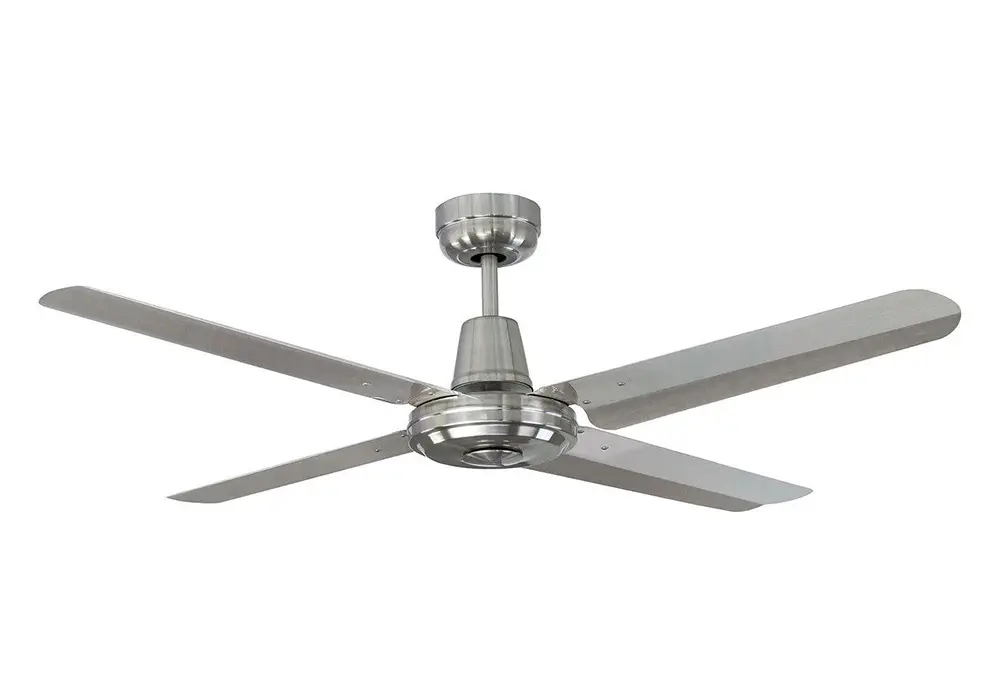
They mostly are made from aluminum or steel and are typically painted white or silver for a sleek look. These types of blades tend to be popular in traditional homes, but they can also be used in modern interiors if you want a little bit of shine in your decorating scheme.
Wooden Blades
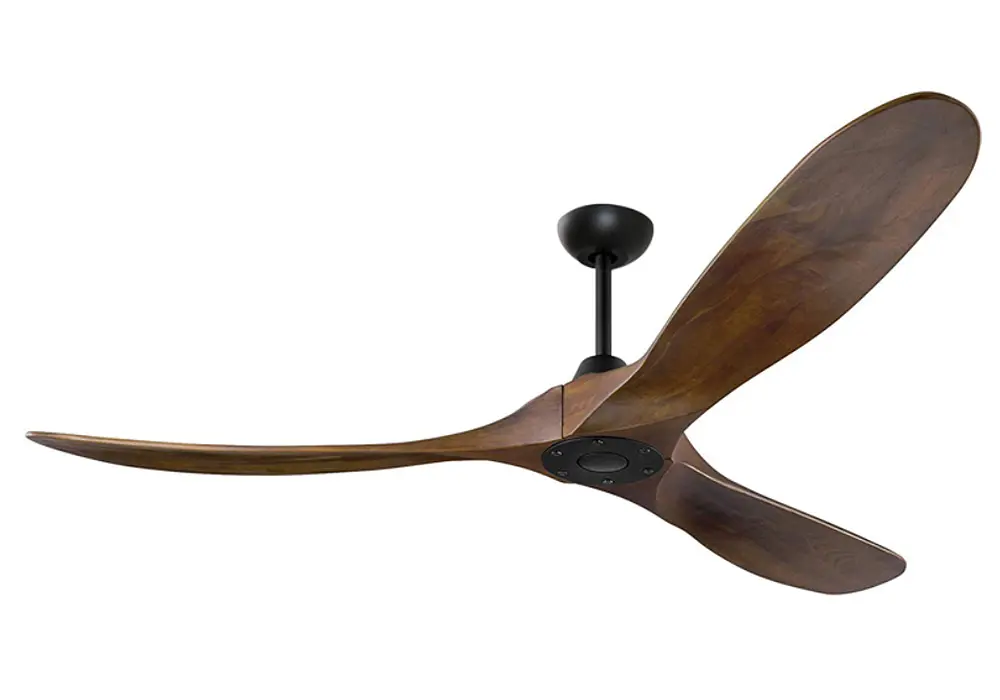
They are made from wood and come in different types depending on the type of wood used and how it’s finished. Wooden ceiling fan blades tend to be more expensive. However, if you want something that looks like it came straight out of an old-fashioned cabin in the woods, then these might be the perfect choice for you!
MDF Blades
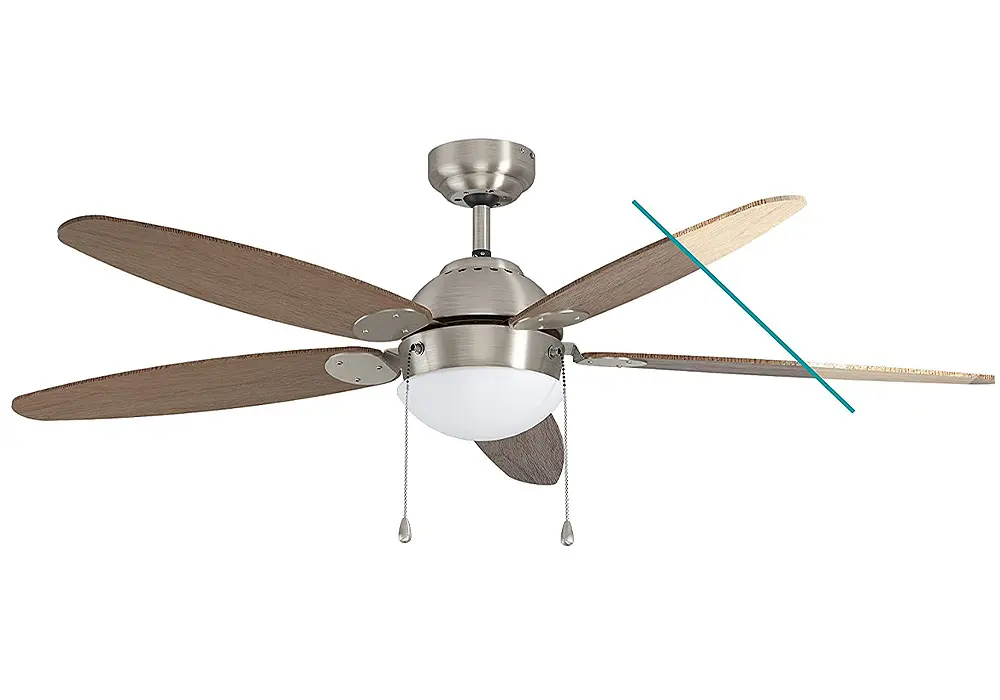
MDF (medium-density fiberboard) is a type of wood composite made from sawdust and resin. It’s cheaper than other types of ceiling fan blades because it’s easy to work with, but it can’t be painted or stained.
Plastic Blades
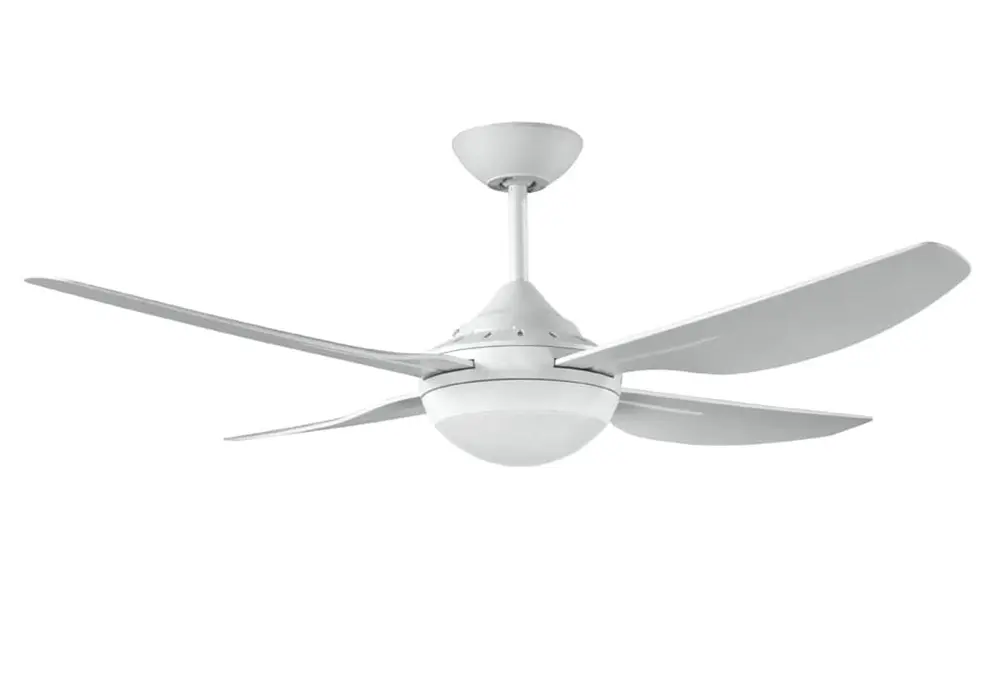
They are made from polystyrene or polypropylene, which means they’re lightweight and inexpensive. They’re also easy to paint or stain if you want a more customized look.
Cloth Blades
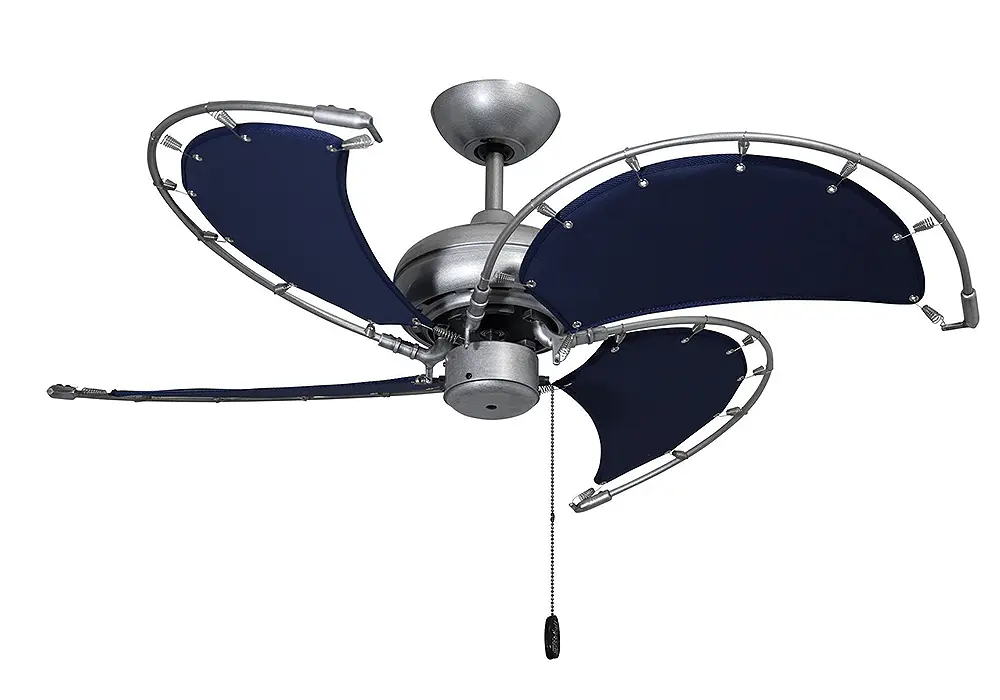
Cloth blades are typically made from cotton or linen, though some companies use synthetic fibers instead (like polyester). They are used in nautical or costal ceiling fans. These are often used for retrofitting older fans because they’re easy to find in antique stores and thrift shops—but they can be difficult to clean and may need regular maintenance over time.
Fact!
Ceiling fan blades are also classified according to their number of blades. They range from one-blade to eight-blade, with three-blade fans being the most common.
There is also a six-blade model, but this is not as common. The number of blades on your ceiling fan will determine how quiet or noisy it will be.
So based on your place/location and type of room, choose wisely the right type of blades!
Mounting Options
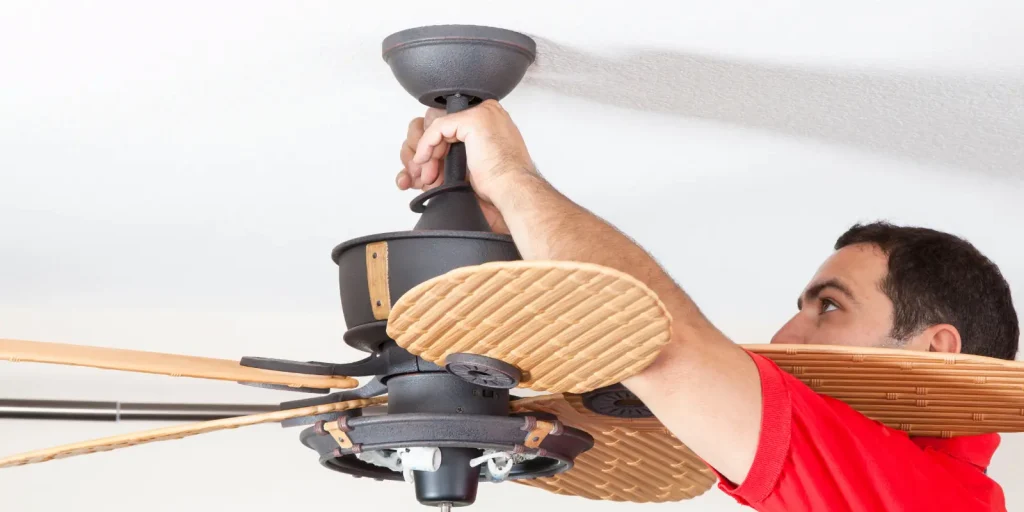
Things you need to know about mounting a ceiling fan
Ceiling fan mounting is the process of placing the fan where it will be in direct contact with the ceiling and giving it enough clearance for proper operation. It’s an important step because it ensures that your ceiling fan will be able to move air efficiently and effectively.
When installing your ceiling fan, you’ll want to make sure that it has enough space behind it so that air doesn’t get trapped by any obstructions. You should also take into account any special features you have installed on your ceiling like light fixtures or electrical boxes (if applicable).
Flush-mount
Flush-mount ceiling fans are the most common and easiest to install. They are mounted directly to the ceiling, with a flat mounting surface that rests flush with it.
This type of fan is best suited to large rooms where there isn’t much space between the ceiling and walls—the installation method is more convenient and requires less work than other types of installation.
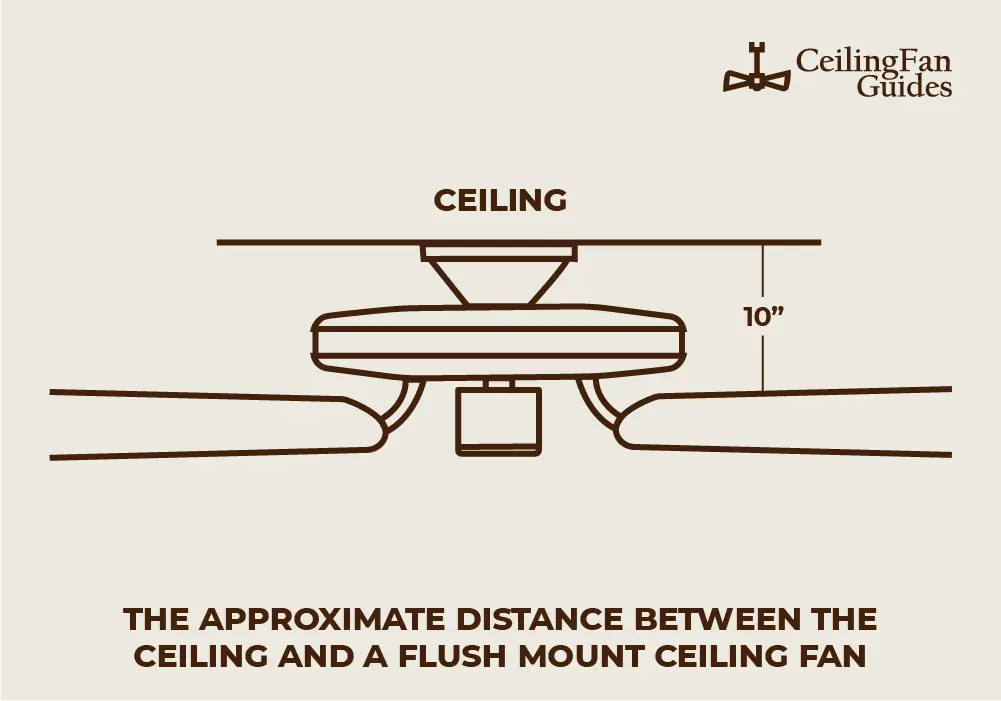
If you’re putting up a flush-mount ceiling fan, make sure there’s at least 10 inches between the fan and the ceiling so the blades don’t touch the ceiling.
Sloped/Vaulted Ceiling Mount
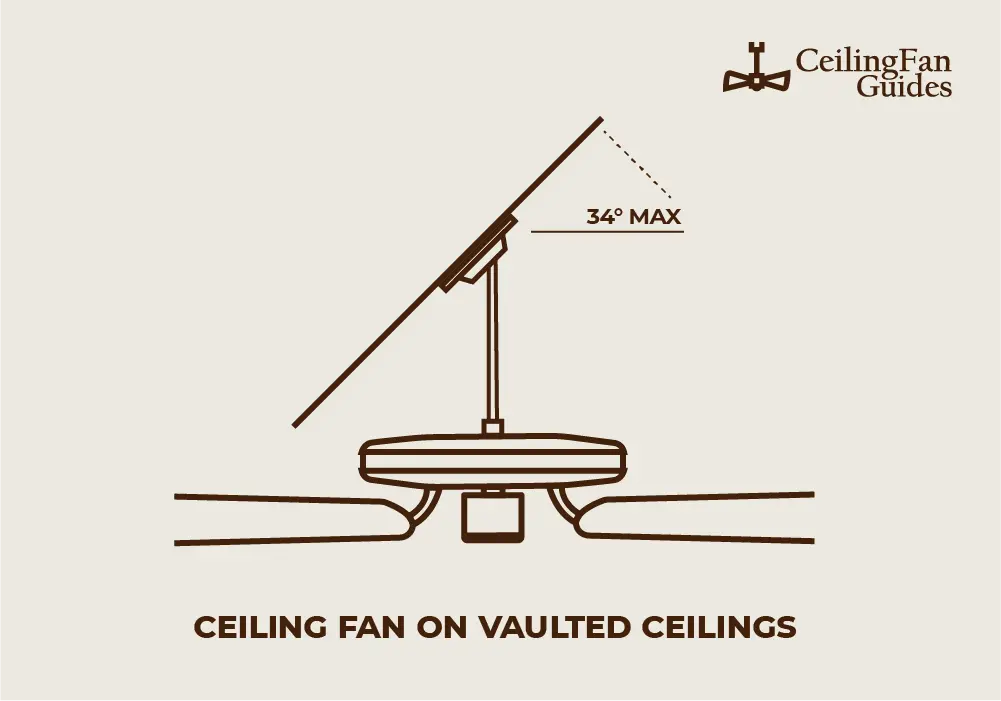
Sloped mounting is for angled ceilings. It’s also suitable for high ceilings, low ceilings, vaulted ceilings, and cathedral ceilings.
The reason that you might want to mount your fan at an angle is that it will allow more air movement when compared with other mounting options. For example, if you have a large assembly area and want cooling air to move away from it rather than toward it as well as onto desks or tables nearby, then this would be ideal!
Standard Mount
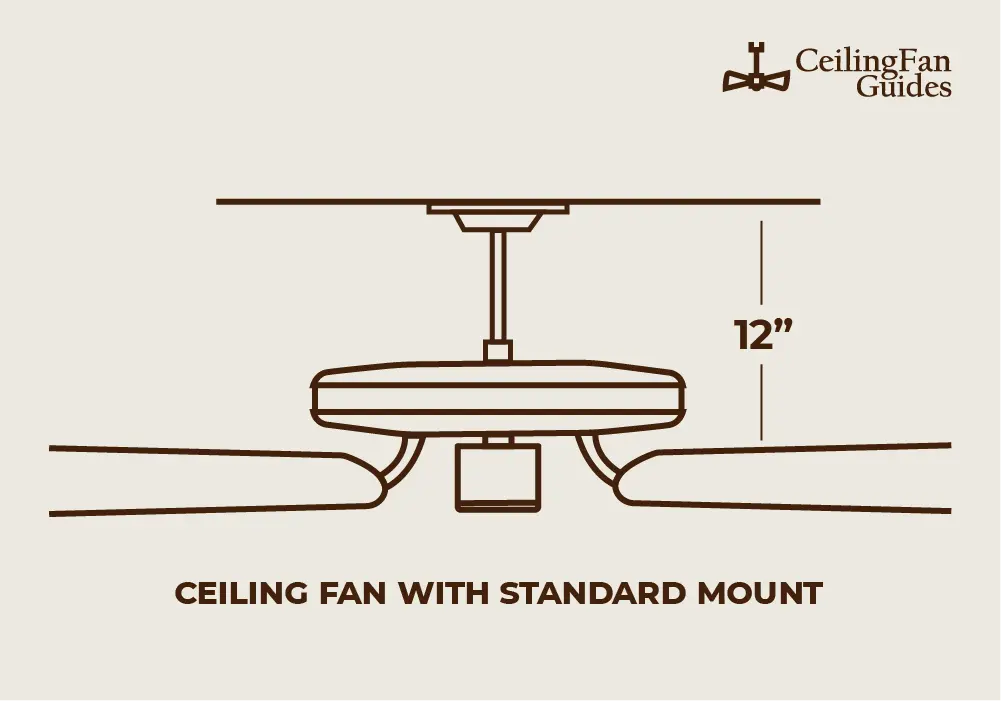
This is the type of mount that you’ll find on most ceiling fans. It has a standard bracket that wraps around the mounting bar, which sits in your ceiling joist.
You can use this type of mount with either a downrod or a 3-inch diameter hole in your ceiling joist; however, you can’t use a downrod with an existing hole in your ceiling joist because it would allow water to enter into your house.
Downrod Mount
This type of mount allows you to install an electrical downrod into your ceiling joist by using an adapter kit.
You can also use this type of mount with a 3-inch diameter hole in your ceiling joist. However, it’s not recommended because if there’s any moisture buildup inside the joists.
For example, when it rains—the humidity can cause damage to the electrical wiring inside the unit.
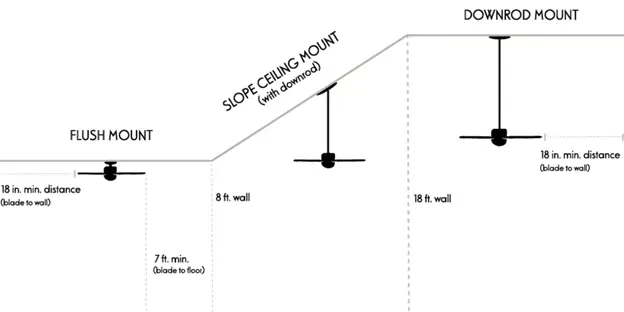
Tip!
The most important factor is how much space there is around the fan. The bigger the space, the more airflow will travel through it. If there’s no space around your ceiling fan, you won’t get much benefit out of it at all!
Ceiling Fan Controls
The first thing you need to know about ceiling fan controls is that there are several different types of controls available, but you should choose only those you require.
Pull Chain Control
The most common and traditional type is a pull chain control. Pull chain controls enable a fan to be turned on/off, its speed and lights to be adjusted by pulling a chain that hangs from it.
The pull chain is linked to a switch that regulates the fan’s power. When the chain is pulled, it activates the switch, which then adjusts the fan’s power and performance. Some fans also have a reverse pull chain switch, which allows the blade to move in the opposite direction for summer and winter use.
Many ceiling fans still use the pull chain control today. For those who do not want to install a more advanced control system, it can be a simple and cost-effective solution.
Wall Mounted Switch
Another most common type of ceiling fan control is a wall-mounted switch.
Wall-mounted switches are also known as dimmer switch control, which is used to control the fan’s speed, lights, and power. These are typically wired to a fan motor through a series of wires.
The wall switch has multiple speed and light control settings, including high, medium-low, or just on/off for power control. Some dimmer switches also come with variable speed control and multi-switch control to control the lights and the speeds individually.
Oscillating Switch
Next, the notable type of ceiling fan control is an oscillating switch. This type of switch allows you to control up to three speeds for each direction: low, medium, and high. It also has a built-in timer so that when it’s turned off (or left on for too long), it will automatically shut itself off after a set amount of time has passed.
Integrated Thermostat Switch
There are also ceiling fan controls with integrated thermostats, which can be installed in both new construction homes as well as remodels or additions. These types of switches can be used with either wall-mounted switches or remote controls, depending on how they’re wired up.
You should check out these controls before finalizing the purchase as they can add more to your ease.
Remote Control Switch
If you’re looking for a more convenient and less expensive option, consider getting a remote control instead. Remote controls can make it simpler and easier to control your fan. You can adjust the fan speeds and lights just with a press of a button. Also, the fan can be operated from distances too.
Nowadays, a remote control is typically included with ceiling fans, making it easy to operate your fan. Before making a purchase, simply check the fan’s specifications to see if a remote is included.
If your fan is not remote controlled, or if you wish to make it compatible with then it simply be installed in your home by an electrician.
Ceiling Fans With Smart Controls
Smart ceiling fans are the newest trend in home automation. They work with your smartphones through Wi-Fi. They are compatible with Alexa, HomeKit, and Google Home, etc.
The best part? They can also be controlled through voice commands!
You can adjust the settings on your ceiling fan without getting up from your couch or bed. If you have an Echo device, all you need to do is say “Alexa, turn on my smart ceiling fan” and it will do it for you!
You can use your smart ceiling fan to control your heating and cooling when you’re not at home, set it up to dim or turn on lights in the evening when you arrive home from work or school, or even turn your smart ceiling fan off when you leave for work so it doesn’t waste energy while unused.
AC vs DC Ceiling Fans: Which one should you choose?
AC (Alternate Current) Fans:
AC ceiling fans are the best option for your home, especially if you’ve got a big family or a lot of guests. They’re easy to install, quiet, and don’t require any maintenance. Plus, they’re energy-efficient and much cheaper than air conditioners or central air.
- Can be installed in any room, anywhere you want to cool off or ventilate the area.
- You can easily install an AC ceiling fan as it only takes a few minutes for you to finish installing this device.
- You can control your AC unit from a remote control device, wall switch, or even by using your smartphone app or smart thermostat controller if you have one installed in your home.
- Not suitable for areas with high humidity.
- Not suitable for areas with high temperature or wind speeds.
- They get dusty faster than other models—which means having to replace filters more often due to dust buildup on blades and motor parts over time!
DC (Direct Current) Fans:
DC ceiling fans are more efficient than AC ceiling fans. The DC motor uses less energy and produces less heat, which makes your home cooler in summer and warmer in winter.
DC fans also have a lower noise level than AC motors. This can be important if you have neighbors or kids who may be sensitive to noise levels.
Read: 6 Best Ceiling Fans For Nursery [Reviews & Guide]
- DC ceiling fans can be installed in rooms with low ceilings, which makes them more energy efficient.
- They don’t need to run as long as the room gets cool.
- They also tend to be less noisy than AC ceiling fans.
- DC fans consume less voltage than AC.
- It will save on energy costs while also being quieter than an AC unit would be if installed in your home’s current setup.
- DC ceiling fans are more expensive than AC fans
But they’re also more efficient and quieter. You can’t beat the cool breeze generated by DC fans, but you might find yourself paying for those advantages when it comes to price.
Performance, Airflow & CFM
The airflow of a ceiling fan affects the comfort of your home. If you want to get the most out of your ceiling fan, you need to know its CFM (cubic feet per minute) and its airflow.
CFM measures the volume of air moved by a fan in cubic feet. It’s often expressed as a number between 4 and 9, with higher numbers of high airflow ceiling fan indicating greater air circulation.
| Room Size (Sq. Feet) | Room Type | Blade Span (inches) | Average CFM |
|---|---|---|---|
| Below 200 sq. ft | Bathrooms, Breakfast Nooks, Utility Spaces, Small Bedrooms, Patios | Under 42″ | 2,000 – 3,000 CFM |
| 200 – 300 sq. ft | Standard Bedroom or Kitchen | 44-50″ | 3,000 – 4,000 CFM |
| 300 – 450 sq. ft | Master Bedroom or Living Room | Over 50” | 4,000 – 6,000 CFM |
| Above 450 sq. ft | Great Rooms, Large Garages, Cellars, and Open Floor Plans | Over 62” | 5,000 – 9,000 CFM |
On the other hand, airflow relates to the speed of the air movement, measured using miles per hour (mph). For example, if you have a ceiling fan with blades that are 24 inches wide and they are moving at 12 mph, then they are moving around 120 mph of air!
The higher the airflow rate, the more air each revolution of a fan will move through your home’s ducts or vents.
Read: The Ultimate Guide to Understanding Ceiling Fan Blade Pitch
Tip!
Make sure for larger rooms where extra ventilation is required, you are choosing a ceiling fan with high CFM and performance airflow.
Electricity Consumption & Energy Efficiency
When you look at the energy consumption of your ceiling fan, you’ll likely see that it’s measured in watts.
Watts measures how much power your fan uses over a given period of time. To calculate your ceiling fan’s annual energy consumption, divide the wattage by 120.
For example, if your fan has an output of 10,000 watts and runs for an hour at a time for five days per week, its annual energy consumption will be 5 kilowatt hours (kWh).
Formula
Electricity consumption = watts x hours/day x 60 seconds/minute x 120 volts = kWh per year
Energy efficiency of ceiling fans is the measurement of the amount of power required to operate a ceiling fan. The higher the energy efficiency, the lower your electricity bill will be.
Calculating your ceiling fan’s energy efficiency isn’t difficult. All you need is this formula:
Formula
Energy efficiency = voltage (V) x current (A) / power consumption in watts
You can also take notes to improve electricity consumption:
Once you have noted these factors before finalizing the purchase, you can grab a quality-wise optimum and a pocket-friendly fan that runs for a long time!
Read: How Much Electricity Do Ceiling Fans Use? [Detailed Guide]
Choosing the Right Ceiling Fan Styles, Designs, Color Options etc.
The style of your ceiling fan can make a big impact on the overall look of a room.
Ceiling fans come in different designs and colors. Depending on what you are looking for, there are many types of ceiling fans to choose from. Here are some common styles:
Popular Ceiling Fan Finishes You Can Buy:
Transitional Style Ceiling Fan
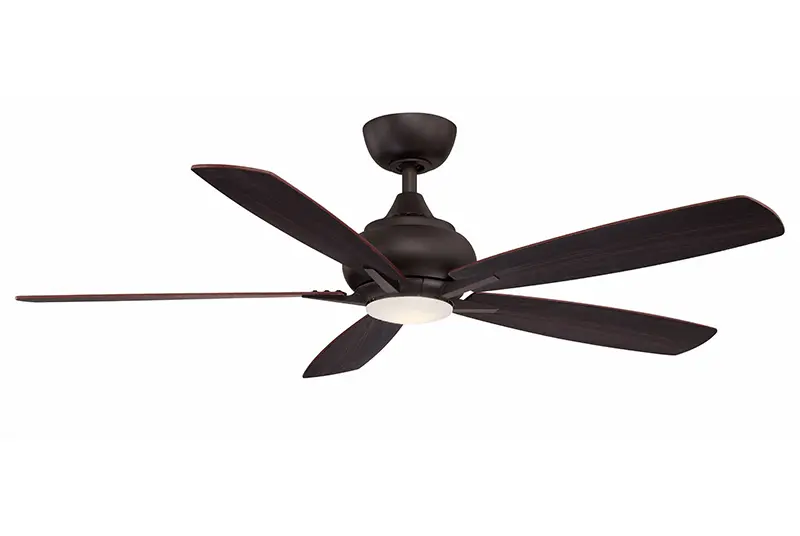
The transitional is a unique style for ceiling fans. It is a blend of traditional style & contemporary style fans. It’s best used in small rooms, but it can be applied to larger spaces as well. It’s a great choice if you want to add some character to your home decor.
Industrial Style Ceiling Fan
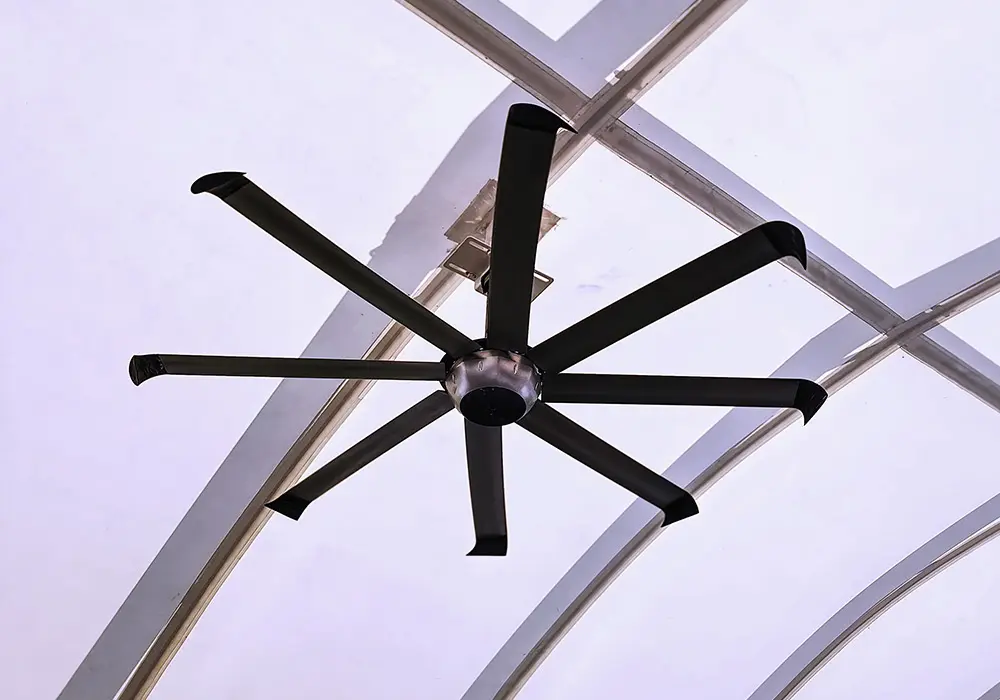
Industrial-style fans are made from metal and have a contemporary look. They are similar to the transitional style, but it’s made from metal rather than wood or other materials. It has a more industrial feel and is perfect for those who want their home to have a more masculine & modern look.
Due to their larger size and more powerful motors, they can be used in industrial or warehouse settings. These fans can be expensive, but they’re perfect for those who want to make their home look like a factory or warehouse space! Their blade size is larger enough to ventilate capacious sitting areas like a pro!
Modern Style Ceiling Fan
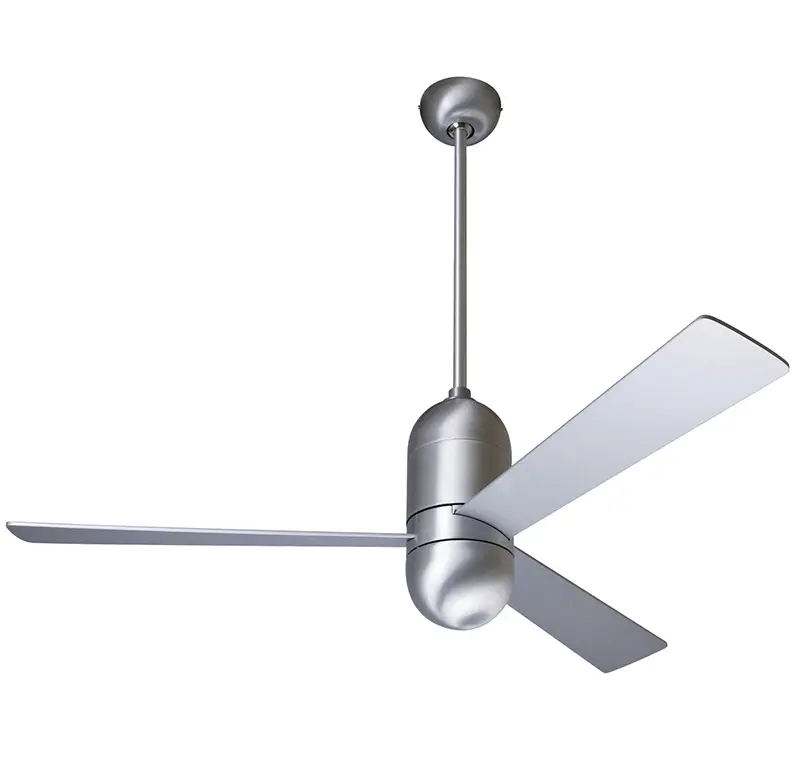
Modern fans are the most common type of fan in homes today, so it makes sense that they would have a more modern and futuristic look than any other type of fan available! Their design features sleek lines and clean lines that are sure to make an impression on guests who visit your home.
Tropical Style Ceiling Fan
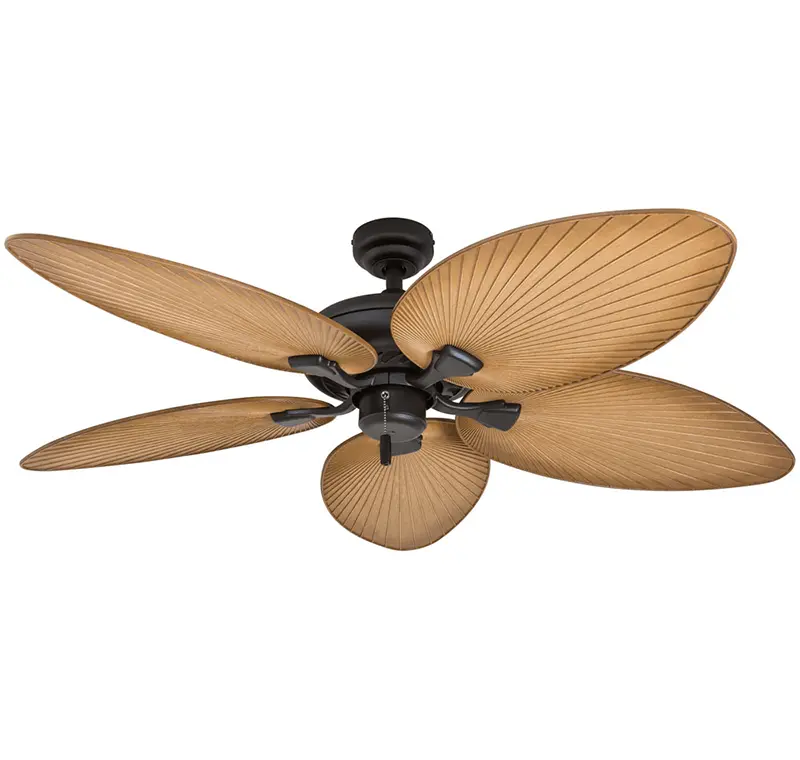
Tropical style fans are designed with a tropical theme in mind. They feature bamboo blades, which look beautiful against a white background while providing good ventilation as well as enhancing the appearance of your space overall.
There are many other styles of ceiling fans also available in the market that you couldn’t choose from due to a long queue.
But don’t worry—we’ve got you covered with this guide to get you started on selecting a great style for your home.
Read: Are Ceiling Fans Outdated?
Colors Available In Ceiling Fans:
Lighten things up with white colored fans
White ceiling fans are great for creating a bright and airy feel in your room, but they can also be a good choice if you’re looking to add some color to a space that’s mostly white or neutral.
Many people use white ceiling fans to create a more open feel, which is great if you have a large room with high ceilings that needs some extra light.
Feel cool with black color fans
Black ceiling fans are an excellent choice if you’re looking to feel cool in your room—especially during the summer months!
These fans look great when paired with white walls and floors, but they also work well with darker tones in general (like brown wood furniture).
They’re also very subtle; so much so that they don’t seem like they’re even on when the lights are off!
Metal fans that sparkle: Brass, bronze, and nickel
Metal fans are perfect for maximizing the amount of light they let into a room—they’re sleek and shiny and help create an open atmosphere in your home or office space.
Brass is reminiscent of something old-fashioned; bronze looks like something golden; nickel… well… Nickel is just cool!
Understanding Ceiling Fans Lights
Ceiling Fan Lighting Defined:
Lumen:
The simple equation is that the more lumens a light bulb has, the brighter it can make a room. It can help you figure out how many bulbs you need for a fan fixture, which can save you money and give you more.
Kelvin:
If the bulb has greater values for Kelvin, it will be cooler in light – likewise, bulbs with less Kelvin range tend to produce yellowish light, having more temperature.
It can help you decide the bulbs that are suitable according to the weather and room conditions. You can go with low Kelvin Bulbs in winters and opposite for summers!
Wattage:
If bulb has high lumen and low Kelvin, it will consume high wattage since it produced both more light and temperature. This can help you choose low-wattage ceiling fan bulbs. It is also important to check wattage if you are looking for energy efficient ceiling fan!
Types Of Light Bulbs Integrated With Ceiling Fans
You can choose from different light styles and make your room more updated. Here is the list!
Branched/Chandelier Lights
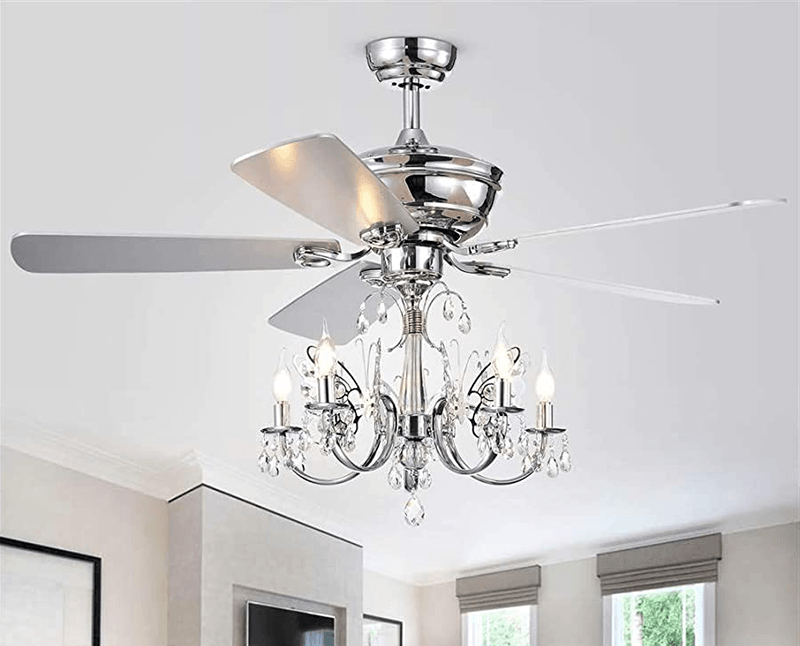
Chandelier Lights or Branched Lights are some of the most popular styles of ceiling lights. They’re made up of branches that extend from one point, creating a cool look and feeling. Branched lights are usually used in residential settings and have a warmer, softer look than other types of lights.
Schoolhouse Lights
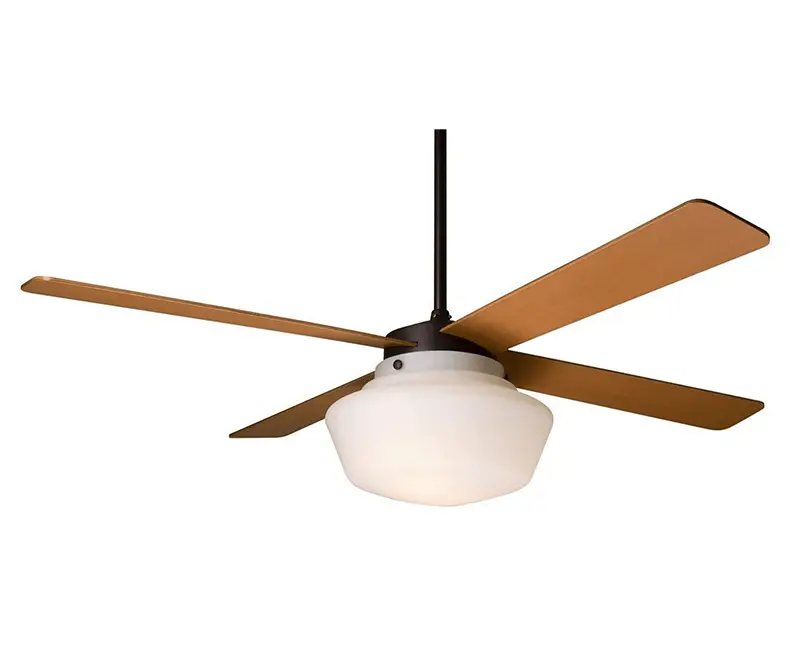
They have a simple, classic design that looks great in any room. These lights come in a variety of colors and styles, and can be used to add brightness or warmth to any space.
Integrated Downlights
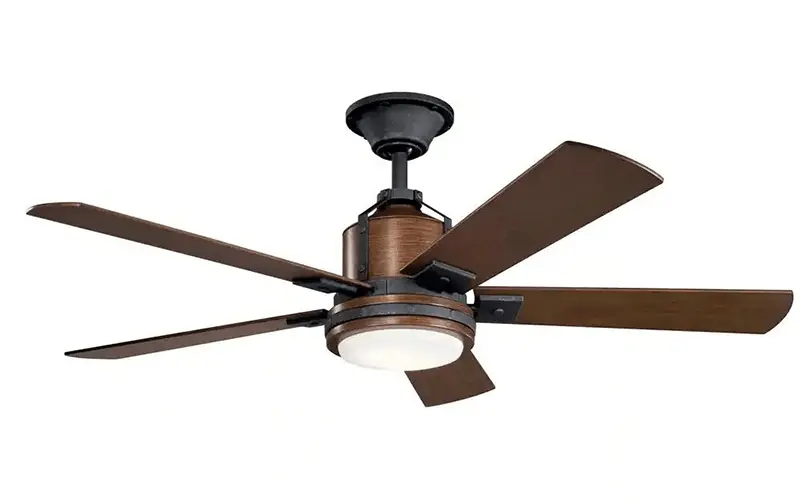
Integrated downlight light fixtures are great for adding both brightness and warmth to your home’s décor. These fixtures come in many different shapes and sizes with different LED capabilities, so you can choose the perfect fixture for your space!
Glass/Candelabra Incandescent Light Bulbs
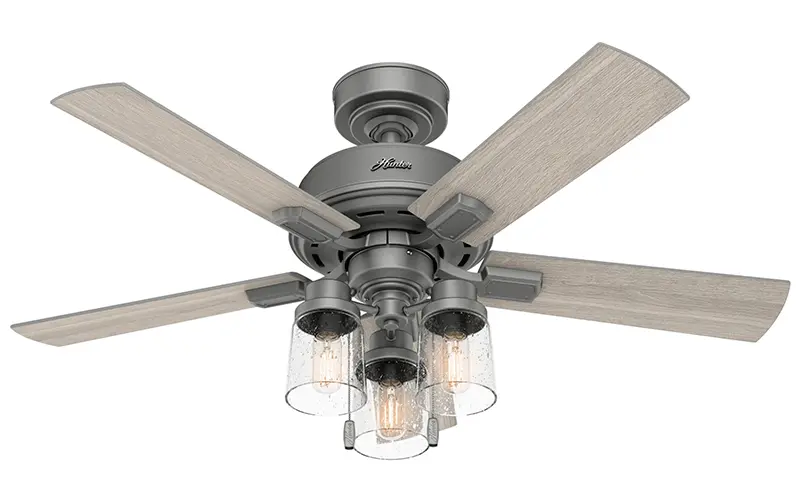
If you’re looking for a traditional light bulb that gives off a soft, warm glow, a candelabra incandescent bulb is the way to go. These bulbs are made from tungsten and are hot enough to emit light when turned on. They’re also quite durable, so they can last for a long time.
Caution!
Since many of you have experienced light-fitted ceiling fans, or you might know how Incandescent Light can be impactful. But in today’s age, find LED light options rather than Incandescent Light because these lights cost more and emit eye-damaging rays if you face up to the fan directly.
Uplights
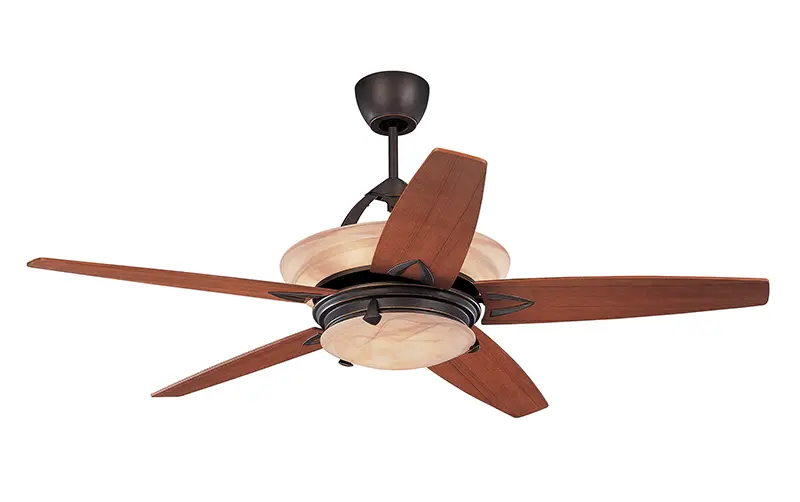
These bulbs are designed to throw the lights in upward direction towards the ceiling to make it glow. It gives off more light than regular bulbs and also use less energy—which makes them even more eco-friendly. Plus, they come in a variety of colors that make your room look lively and fun!
LED Light Bulbs
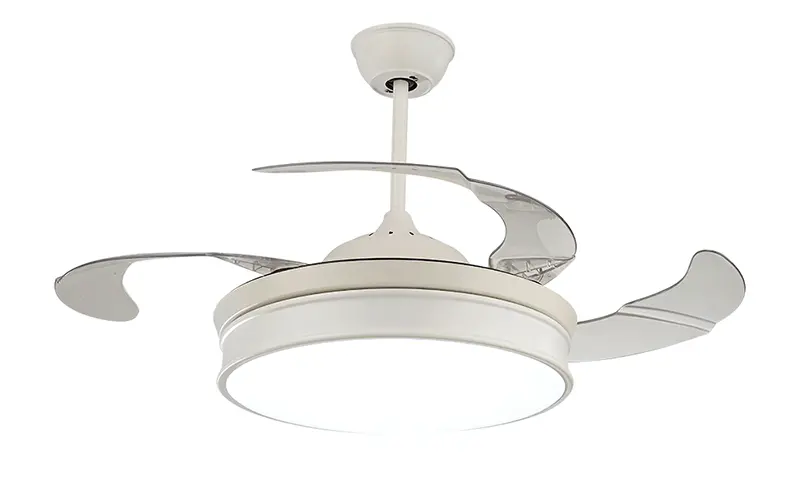
If you’re looking for something even more eco-conscious than an uplight bulb, then look no further than the LED bulb. LEDs have become very popular in recent years because they use less energy than traditional incandescent lights while still producing bright light.
Tip!
We suggest finding a Halogen Light ceiling fan that consumes 15% less electricity than Incandescent Light, OR invest in a more reliable LED light fan that consumes 75% less energy than Incandescent Light.
Popular Ceiling Fan Brands
When we’re looking for ceiling fans, it’s important to know what brands we’re going to be able to buy. There are a lot of different brands out there, and they all have their own specialties.
The most known of these brands are:
Hunter
Hunter ceiling fans are a trusted brand, that started manufacturing ceiling fans in Memphis, Tennessee, and was recently owned by The Ames Companies in December 2021.
It has been around for more than 100 years and prides itself on its ‘built to last’ construction attitude, offering products that include ceiling fans, glass shades, fitters, downrods, caps, and adapters.
This attention to detail helps ensure that the fans will last for many years to come without any major issues occurring over time, such as motor bearing failure or other mechanical problems related to poor-quality components.
Apart from being a reliable brand, the Hunter has made other brands as well, including Casablanca and Jan Fan. This way, if you are looking for specific types of ceiling fans to install in your home, e.g., wifi integrated, remote control, and other latest featured fans, this brand serves you the best options!
Casablanca
This is basically the sub-brand of hunter company and offers fans having a modern look that can be used in any room of the house. The company was founded by Hunter ceiling fans in 1996, but Burton brought the brand to life in 1974.
The founder helped develop the company’s signature designs and made sure that every fan was made with quality materials. Today, after being merged with Hunter in 2017, Casablanca fans are known to be energy-efficient and lightweight, making them perfect for any room in the house.
That is why, it comes as an extension of Hunter fans specializes in manufacturing ceiling fans that are lightweight and exceptionally energy-efficient.
Craftmade
Craftmade fans are made in the USA with no toxic finishes or materials. Since 1985, they’ve been one of the largest multichannel suppliers in the United States. Their fans come in a variety of styles, including modern, transitional, and traditional, and they’re all designed to be energy efficient.
But the most exceptional thing that differentiates this company from other ceiling fan manufacturers is its affordable products. Since the company has multiple locations in different countries out of the USA, it focuses on providing numerous options for home decor items that are easy on pocket and sturdy in composition.
When you go to their website, you find different options to figure out your desired ceiling fan, starting from choosing between motor type (AC/DC), product type (switch, remote control), build type, mounting locations, and so on.
Therefore, this brand is all good for those looking for brands in the USA serving people with their desired ceiling fan options!
Emerson
Emerson was founded in 1890 in St. Louis, Missouri, as a manufacturer of electric motors and fans. In 1995, Emerson was acquired by Siemens AG, now the largest home appliance manufacturer in Europe. Emerson manufactures a wide range of commercial and residential ceiling fans and lighting products.
Emerson serves the following markets:
They are also known for their dependable structure, effortless style, and high-quality motor construction. These fans continue to be industry leaders in motor construction because they offer a wide range of products at competitive prices.
Fanimation
Fanimation is a company that started as a side project for Tom Frampton in 1973. After working for Burton A, Frampton decided to start his own ceiling fan company in 1984, working out of his garage in Pasadena until demand for his product outgrew the space.
The fans can be found in many different styles, including contemporary, country, and traditional. They come with a lifetime warranty on parts and workmanship, so you can be confident that they will last for years to come. So, it can be a better option if you are looking for damp-rated and wet-rated ceiling fans in a variety to choose from!
Kichler
Kichler is a long-standing brand that has been manufacturing ceiling fans since 1938. The company was purchased by Masco Corporation in 2018, which means you can now find Kichler products in almost every major retail store.
In addition to their extensive selection of fan styles and finishes, Kichler also offers a wide range of accessories to help you customize your fan’s look: fans with light kits, fans with remote controls, fans with dimmer switches, fans with USB ports, fans with wood blades, fans with downrods, and more!
The company includes their Gold Leaf collection and the Copper Leaf collection. These fans have a modern aesthetic and will match any room in your house.
Matthews
Matthews Fan has been in the ceiling fan business since 1992, when Chuck Matthews founded the Matthews Fan company in his hometown of Chicago. He has since expanded his manufacturing operations to include the production of ceiling fans at their facility and leverage company to Libertyville, IL, forty miles north of the city of Chicago.
It offers fans with an industrial feel. They offer fans that come in many colors and styles, including their Modern Wall Fan Collection and their Modern Form Collection. The fans are famous also because the motors are made in the USA and deliver powerful output.
Minka Aire
This Calfornia based company has been around since 1939 and offers an array of products for both interior and exterior use. Their fan options include wall-mounted fans as well as floor standers. Most models have LED lights that can be customized to your liking.
Minka-Aire also makes floor fans, pedestal fans, oscillating fans, portable fans, ceiling fans with light kits, and more! They have an extensive line of ceiling fans that are Energy Star Certified. Their fans are also very affordable and come in different price tiers, so you can find one that fits your budget.
Modern Fan Co
The company has been around since 1989, making them one of America’s oldest manufacturers of ceiling fans! They make all kinds of different styles, including metal models that look like they’ve been around since before electricity was invented.
By proving decades of service in the market, the company has built a reputation that is impeccable. They have a wide variety of styles available, including modern, transitional, and alabaster styles. They also have some unique designs that you won’t find anywhere else on the market!
Modern Forms
Modern Forms is an elegant ceiling fan brand that is brought to life by the intricate designs of its fan blades. They are made in China but have a distinctively Scandinavian aesthetic—a sophisticated perspective that never goes out of style.
The brand specializes in modern ceiling fans, which are the fan of choice for most people today. Their products are made from an aluminum alloy that is extremely durable and long-lasting, which means you can expect these fans to last for years.
Monte Carlo
Founded in 1996 by Markwardt and Mike, the Monte Carlo Fan Company is located in Fort Worth, Texas. The company was founded after they discovered the need for a fan that could be used in high-stress areas.
With over 20 years of experience in the ceiling fan industry, they continue to push the limits of innovation while remaining committed to providing their customers with quality products at competitive prices.
Monte Carlo ceiling fans are designed with an Italian-inspired style, making them absolutely stunning. Their fans have a curved design that looks beautiful in any room of your home. They also come with their matching light kit, making it even more appealing!
Oxygen
Oxygen has headquarters in Fort Worth, Texas. They are privately held and have been in business since 2000. They specialize in decorative indoor ceiling fans and lighting solutions for any commercial or multi-family application.
Oxygen is one of the most popular brands today because they offer some of the highest quality ceiling fans at an affordable price point. They use high-quality materials such as copper and steel in their designs, so they’re sure to look great in any room!
Now, the question is where to buy these brands that promise good customer support so you don’t need to replace the product repeatedly!
Where To Buy Them?
If you’re buying online, there are many places where you can buy ceiling fans. Some of these include Amazon, Home Depot, Lowes, Lumens, Hansen Wholesale, Houzz, Lighting Direct and Walmart (among others). When choosing a store that sells ceiling fans, remember that most stores sell similar items, so it might be hard to find one that has everything you want.
These stores are great because they often have the best prices on ceiling fans and other home decor items. They also have great customer service and can help you find what you’re looking for if you don’t know where to start!
However, if you know exactly what type of fan you want and what features matter most to you, then it should be easier for you to find one at any store!
Read: Made In USA Ceiling Fans – Do They Exist?
Also Check Out: 5 Luxury & Most Expensive Ceiling Fans
From where can I buy ceiling fan accessories?
You can buy ceiling fan accessories from a variety of places. Here are some options:
How To Install Ceiling Fans?
Once you have picked the right ceiling fan for your room, now install it easily using a few tools if you have prior experience in installing fans.
To install a ceiling fan, first, remove the plastic cover from the ceiling. Then, place it on a flat surface.
Next, attach the electrical box to the ceiling with screws and nuts. Attach the blades to the motor by screwing them into place with a screwdriver.
Finally, connect the wires to each bulb socket by matching up the color of the wire to its corresponding socket.
Read: How To Install A Ceiling Fan Without Existing Wiring? [Detailed Guide]
Caution!
If you haven’t installed a fan ever, don’t take a risk, and call a professional to do the job!
Also Read: How To Wire A Ceiling Fan? [Detailed Guide] & How To Troubleshoot A Ceiling Fan
Cleaning Your Ceiling Fan
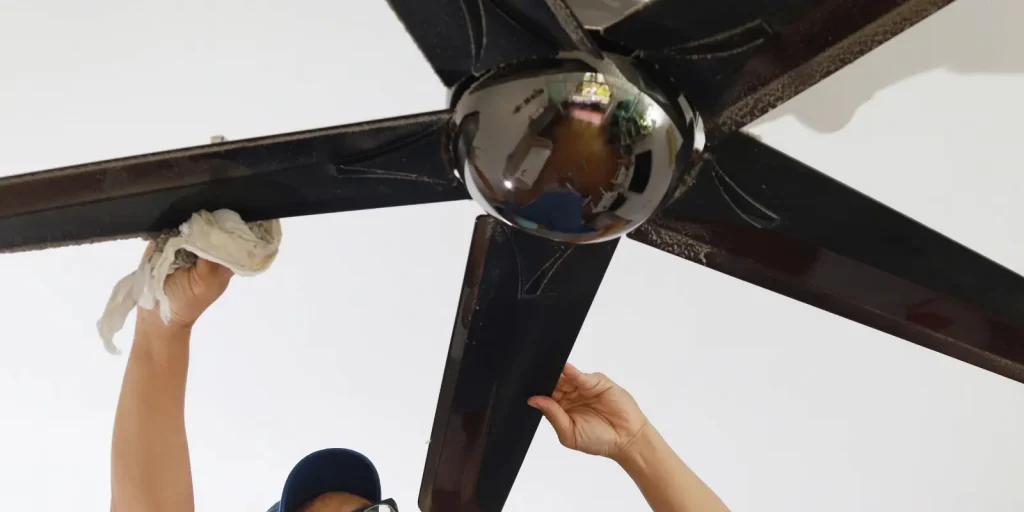
Cleaning your ceiling fan is an easy way to keep it looking new.
You first need to unplug the fan and unscrew the light fixture to access the body. Now vacuum the dust use a cup of white vinegar and a little water to quickly clean the blades, but you can also use a cloth with warm soapy water.
Just make sure the blades aren’t wet when you’re done cleaning them!
Check out: Complete Guide Of Cleaning Ceiling Fan
FAQs – Hold on! We’ve got some more info for you!
What is a bladeless ceiling fan?
A bladeless ceiling fan is one that does not use blades. Instead, it is driven by a motor and has a flexible head that can be directed in any direction. These fans come in many different designs but are generally more energy efficient than traditional fans that have blades.
Are 3 or 4-blade ceiling fans better?
The answer is: It depends.
If you have a lot of ceiling space, or if you live in a home that is open to the elements, a 3-blade fan might be better for you. If you have smaller ceilings and/or don’t live in an area that gets much direct sunlight, a 4-blade fan may work better for you.
Which brand of ceiling fan is most reliable?
Hunter Fans is one of the best brands of ceiling fans that is most reliable. Hunter fans have been a long-standing name in the ceiling fan industry and always stand behind their product.
They offer a full warranty on all of their products, which means you can rest assured that if anything goes wrong with your new Hunter fan, you’ll get it fixed or replaced with good customer support.
What happens if the ceiling fan is too big for the room?
If the fan is too big for a room, it will not be able to do its job properly. If you want to keep your ceiling fans running smoothly, make sure that you check the size of the blades before buying one. You should also look at how much space there is between the blades and the ceiling.
Conclusion
The key to buying a ceiling fan is knowing what kind of space and lighting conditions you’re looking for—and then finding one that fits those requirements.
If your home is a single-story, light-filled space with no windows, you’ll want to pick a ceiling fan that has lights that can be dimmed. If you have a large living room with lots of natural light coming in through the windows, you may prefer an oscillating fan that moves air around rather than an electric model that only spins.
Similarly, If you want to be able to use your fan in multiple rooms at once, look for a model that can be mounted on the wall or ceiling using screws or pushpins. This will help keep the installation process simple and quick.
Similarly, keep an eye on other factors as well that make a ceiling fan highly convenient and useful. Ensure that you have checked fan types, blades, size of room, brightness required, and electricity consumption before purchasing the fan. This will never let your hard-earned money go to waste!

